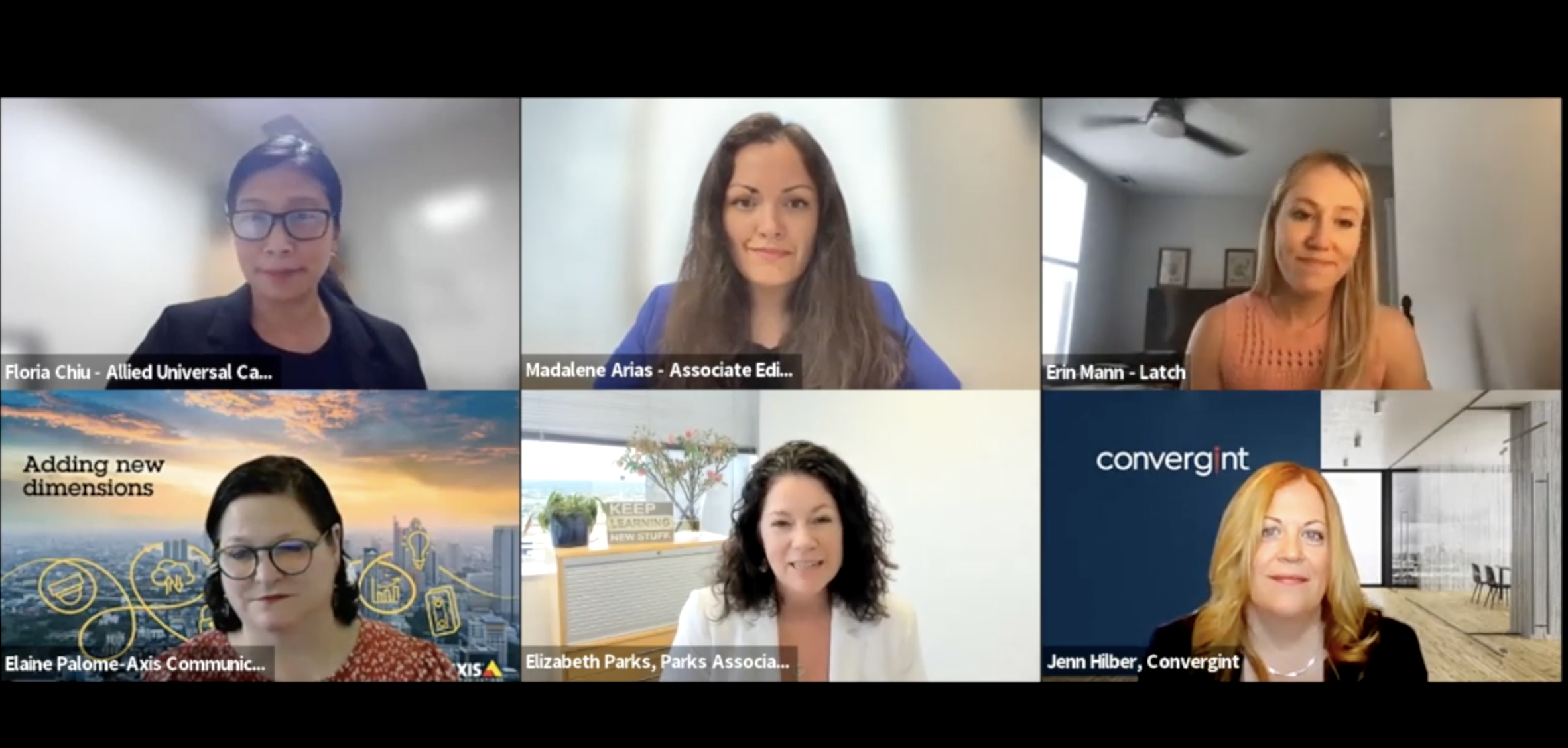
SP&T News and Canadian Security cover some of the most pressing issues facing the security industry, including the balance of skills required of its newest technicians and alarm installers in our most recent cover story.
Security contains a varied range of career opportunities, yet it continues to be an industry where women remain underrepresented.
On Wednesday May 31, 2022, SP&T News and Canadian Security brought together some of the most talented and accomplished women in security in a virtual event called “Advance: Women in Security” to learn from them what needs to change so that more women feel welcomed into security roles and empowered to achieve their goals in this field. The event was sponsored by GardaWorld and Winsted.
Madalene Arias, associate editor, SP&T News and Canadian Security, moderated the first panel for the afternoon which focused on recruitment and retention; ways to increase diversity and representation in the security industry; and how to support women throughout their careers.
Arias was joined by:
- Elizabeth Parks, president and CMO, Parks Associates
- Floria Chiu, enterprise account executive, Allied Universal Canada
- Jenn Hilber, business architect, Convergint; chair of Convergint Women Connect affinity group
- Elaine Palome, HR director, Axis Communications
- Erin Mann, city manager, Toronto, Latch
Arias asked the panelists what made them stay in their chosen careers, what the industry is doing well in terms of recruiting talent and where it can improve as well as what initiatives seem to be working well. She also asked how the industry can keep successful women in the profession and whether there is room for advancement and sufficient incentive to stay.
According to Palome, asking what can be done to recruit and retain more women is a broad based question, yet at least a couple of things have come to mind for her.
“One of the things that we’ve been trying to do here at Axis is make sure that our postings are what we call gender neutral, and that’s everything from changing words to ‘chairperson’ instead of ‘chairman’. Also just using what we call family-friendly perks in our ads,” Palome told the panel.
“Job postings that were gender neutral had 29 per cent more applications, which in our candidate-driven market such as what we’re now at is huge.”
In terms of recruitment and attracting women to security careers, Chiu said women need to become spokespersons for the industry, using their voices to highlight all of the different career paths that exist.
Hilber, whose background is in finance, pointed out that not all professionals in the industry are out in the field, installing equipment. Hilber emphasized that the industry holds positions in areas such as HR and marketing among others, and part of attracting more women is to raise awareness about these positions.
As far as initiatives that have served women well in their security careers, Mann applauded scholarship opportunities that have made professional development more accessible to women as well as those that have enabled them to attend conferences and build their networks.
But where the industry falls short of making a genuine effort to be more inclusive and diverse is in hiring women to meet a “balanced” ratio of women to men in a workplace.
Mann reiterated that ultimately, the industry should work to break down barriers so that people of all identities can have equal opportunities to success based on their individual talents. The intention should not be to give females opportunities because being female makes them more deserving.
“I am deserving, and my identity is female. And those two things are very powerful, individually, but extra powerful combined.”

Next, SP&T News and Canadian Security editor Neil Sutton led panelists through the second discussion of the afternoon which focused on the role of security associations, peer networking and mentorship.
Sutton was joined by:
- Helen Perry-Raycraft, assistant regional vice-president, Region 6C (Sask., Alta. and B.C.) ASIS Canada; Women in Security liaison, ASIS Sask. Chapter; Member-at-large, CANASA National Board; vice-president & COO, Brigadier & Elite Security Systems
- Joanne Robertson, board member, CANASA B.C. Council; member, CANASA National Working Committee; director of sales, West, Inaxsys Security Systems
- Ceres Silva, chair, WIS, ASIS Toronto; council member, CANASA Central; member, SIA Women in Security Forum; founding member, Immigrant Women in Business of Canada; Canadian sales director, Eagle Eye Networks
- Returning for the second panel, Erin Mann, who, in addition to her role at Latch serves on the Board of Directors for the Foundation for Advancing Security Talent (FAST), is the vice-chair of SIA’s RISE Steering Committee for young professionals, a member of SIA’s Proptech Advisory Board, and a member of the SIA Women in Security Forum and the Canadian Women in Security Forum
Sutton asked the panelists how they’d become involved with their respective associations, whether there were any specific initiatives within these associations that were leading the way for women, and how the industry can encourage mentorship.
Silva is a founding member of Immigrant Women in Business Canada in addition to her roles with ASIS Toronto and CANASA. She explained that earlier in her career she had joined the association in search of mentorship and opportunities for professional development. She would eventually become a mentor herself and help younger professionals.
Silva explained that the value of associations is the opportunity to provide women with support in industries where they may not otherwise have it.
“Just think, there are only 12 per cent of women in tech or STEM roles around the world, so having that part in the association gave me the skillset to also be a mentor in a different part of different associations where women are lacking that support,” said Silva.
Perry-Raycraft commended both CANASA for their hard work towards ensuring the industry recognizes women in security and encourages inclusiveness of younger professionals and underrepresented populations.
Specifically, Perry-Raycraft said she has witnessed a push to include women in different forums happening at the chapter level and the national level.
She highlighted that only 12 per cent of women in Canada are involved in security associations, a number she considers to be low given that many more women are involved in the industry.
Robertson added that security associations are effective in giving women spaces to network and bring issues that concern them to the forefront through panel discussions, for instance. Associations have also proven effective in giving women a platform to educate others outside of the security industry on what it means to be a security professional.
“Security is such an umbrella term for all of the avenues that you can use in this industry. You say ‘security’ to one person, and it means something else to somebody else, and it would mean something else to me.”
Panels are currently available on-demand on the event website, as are sessions from sponsors GardaWorld and Winsted.
Print this page
Advertisement
- Ajax Systems partners with Inaxsys for Canadian distribution
- SIA surpasses 100 OSDP verified products
